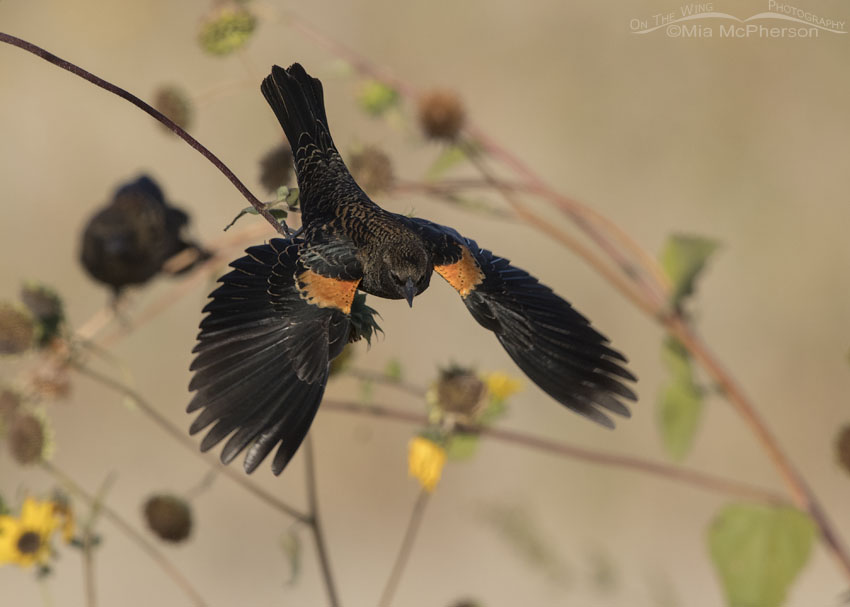 Juvenile male Red-winged Blackbird diving towards the ground – Nikon D500, f7.1, 1/2000, ISO 640, Nikkor 500mm VR with 1.4x TC, natural light
Juvenile male Red-winged Blackbird diving towards the ground – Nikon D500, f7.1, 1/2000, ISO 640, Nikkor 500mm VR with 1.4x TC, natural light
The plumage of male juvenile Red-winged Blackbirds is highly variable during their first year, some of the young blackbirds can look like females and some can look more like adult males.
Red-winged Blackbirds are sexually dimorphic, adult males are primarily all glossy black with red and yellow epaulets while the females are a streaky dusky to brown with a light “eyebrow” that can be white to buff to salmon colored. Females are often confused with sparrows and other bird species by novice birders and bird photographers.
The juvenile Red-winged Blackbird male in my photo above looks more like an adult male than a female. Instead of being all glossy black though this young male has rusty to buffy edges on the feathers of his head, nape, mantle, coverts, back and tail. His epaulets are orange with black mottling instead of red and yellow.
When I photographed him on Antelope Island State Park two days ago he and a flock of other Red-winged Blackbirds were feeding on the wild sunflower seeds, he had been perched on a stem next to a seed head and I happened to photograph him as he dove towards the ground after a seed he had dropped.
Normally this photo would have been consigned to my delete bin because of the lack of eye contact but I decided to keep it because I liked the diving pose, the spread wings, the lifted tail, that one foot is still touching the sunflower stem and how well this image shows the plumage phase of this individual juvenile male bird. I do wish I would have had eye contact with him and that the seed head under the bird’s right wing hadn’t been there but this is a bird not a model and they do what they want to when they want to, where they want to and how they want to. I wouldn’t have it any other way.
Life is good.
Mia
Click here to see more of my Red-winged Blackbird photos plus facts and information about this species.


Mia, Congratulations on your article in Birding!! Great shots of the Grebe and well written article.
Thanks Dick, it was a real honor to work with Peter on the article.
Splendid! Absolutely splendid!
I did notice your site was down yesterday – and am glad to see you back.
Echoing Laura here.
I have often wondered if the colored fringe wears off the edge of the feathers by next spring, similar to starlings, leaving the remaining feather a glossy black we then see.
I love pictures that show the normal doing of the bird and you have captured it perfectly.
Thanks for sharing your talent
Beautiful image! Love the spread of the wings and the colorful red and gold shoulder patches…these birds are some of my first spring visitors, arriving with grackles, starlings and rusty blackbirds…
Just an FYI, when I post a comment here, I get a message that it’s a duplicate. However, everything SEEMS to be posting normally. Computers are EVIL
What an exquisite image! I just love it for all the reasons you listed, especially the feather detail. Personally, I’m not fussed with the eye catch–I’m happy when it’s there or not. I fully understand the degree of difficulty aspect, too. All things considered, this is an outrageously beautiful shot!
What a wonderful shot.